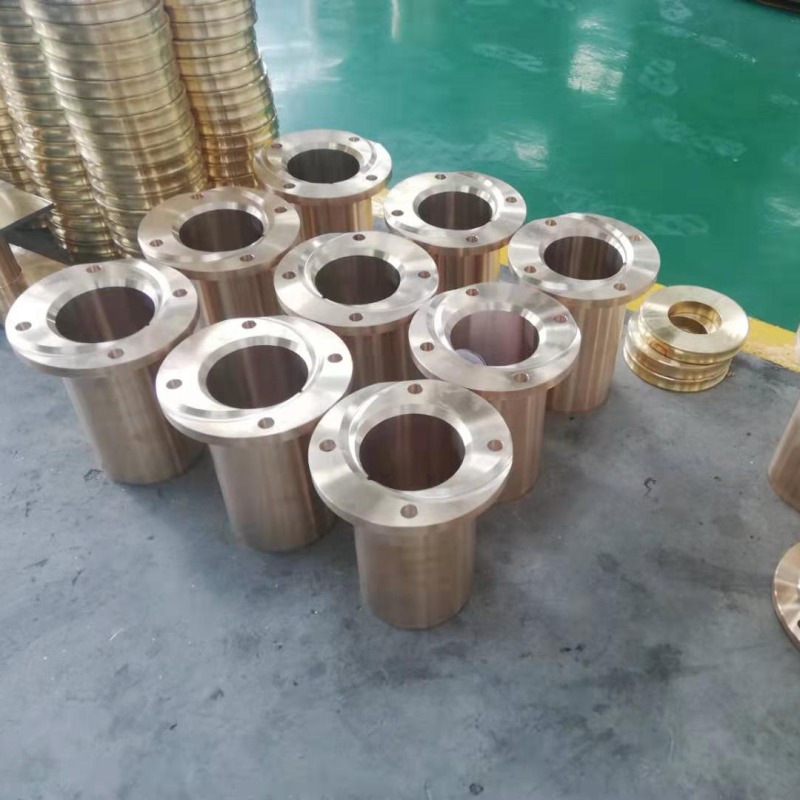
Home > News > Industry news > How to determine whether the flange copper sleeve needs to be replaced?
The following aspects can be used to determine whether the flange copper sleeve needs to be replaced:
First, observe the appearance
Check the surface wear:
Carefully observe the surface of the flange copper sleeve to see if there are obvious signs of wear. Under normal circumstances, the surface of the copper sleeve should be smooth. If there are wear grooves, scratches or uneven wear areas, it means that the copper sleeve has been subjected to greater friction during the working process and may need to be replaced.
A magnifying glass or microscope can be used to get a clearer view of surface wear. In the case of heavily worn bronze bushings, the dimensions may change, affecting the accuracy of the fit to the shaft.
Look for cracks and breakage:
Check the brass bushing for cracks, breaks or fractures. Cracks can be caused by excessive load, impact or fatigue. If cracks are found in the copper bushing, it should be replaced immediately to prevent more serious damage from occurring during operation or even causing equipment failure. Breaks and fractures are usually caused by external impact or improper installation. Once the copper bushing is found to be broken or fractured, it must be replaced in time to ensure the safe operation of the equipment.

Measuring Dimensions
Inner diameter measurement:
Use the inner diameter micrometer or inner diameter percentage table and other measuring tools to measure the inner diameter of the flange copper sleeve. Compare the measurement results with the design size, if the inner diameter size exceeds the allowable tolerance range, it means that the copper sleeve has been worn excessively and needs to be replaced.
Changes in the inside diameter will affect the fit clearance with the shaft. Excessive clearance will result in increased shaft wobble, reducing the accuracy and stability of the equipment.
OD Measurement.
For flanged copper sleeves mounted in the housing, the outside diameter also needs to be measured. Changes in the outside diameter may affect the tightness of the fit between the bushing and the housing. If the O.D. becomes smaller, it may cause the bushing to loosen in the housing, affecting the normal operation of the equipment.
Use tools such as an outside diameter micrometer or vernier calipers to measure the outside diameter and compare it with the design size.
Third, check the fit clearance
Fitting clearance with the shaft:
Insert the shaft into the copper sleeve, and check the fit clearance between the shaft and the copper sleeve by feeling or using tools such as a stopper. Under normal circumstances, the fit clearance should be within the design range. If the clearance is too large, the bronze bushing is badly worn and needs to be replaced.
Excessive fit clearance will result in increased radial runout of the shaft, affecting the accuracy and smoothness of operation of the equipment. At the same time, the clearance is too large will also make the lubricant leakage, reduce the lubrication effect, accelerate the wear of the copper sleeve.
Matching tightness with the shell:
For the flange copper sleeve installed in the shell, check the tightness of the fit between the copper sleeve and the shell. You can gently tap the copper sleeve, listen to the sound to determine whether the fit is loose. If the sound is hollow, the fit between the bushing and the housing is not tight and may need to be replaced.
A poor fit will cause the copper sleeve to shift during operation, affecting the normal operation of the equipment. At the same time, the loose copper sleeve may also cause vibration and noise, reducing the service life of the equipment.

Fourth, monitor the operating status of the equipment
Temperature changes:
During the operation of the equipment, regularly use a thermometer and other tools to monitor the temperature of the flange copper sleeve. If the temperature of the copper sleeve is too high, exceeding the normal operating temperature range, it may be due to serious wear and tear of the copper sleeve, poor lubrication or overload and other reasons.
High temperatures will accelerate the wear of the copper sleeve and reduce its service life. At the same time, the excessive temperature may also cause damage to other parts of the equipment. Therefore, when an abnormally high temperature of the copper bushing is found, it should be inspected and considered for replacement in time.
Vibration and noise:
Pay attention to observe the vibration and noise of the equipment during operation. If the equipment appears abnormal vibration or noise increases, it may be the flange copper sleeve problems. A badly worn bushing can cause an imbalance in the shaft, which can lead to vibration and noise.
Constant vibration and noise can cause damage to the structure and other components of the equipment, reducing its reliability and service life. Therefore, when abnormal vibration and noise are found, the condition of the copper bushing should be checked in time and replaced if necessary.
+86 17719955658
AddMazhuang Village, Yuhe Town, Huixian City, Xinxiang City, Henan Province, China
E-maildora@hsjxchina.com
Copyright @ 2025 Haishan Bronze Casting No:84463
Copyright @ 2025 Haishan Bronze Casting
Copyright @ 2025 Haishan Bronze Casting